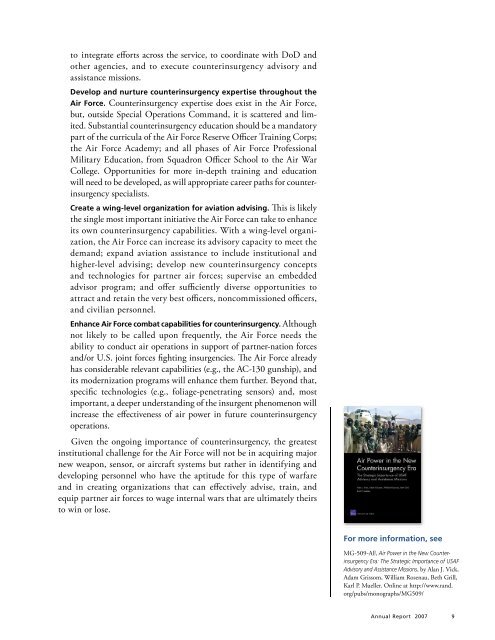RAND Project AIR FORCE Annual Report 2007 - RAND Corporation
RAND Project AIR FORCE Annual Report 2007 - RAND Corporation
RAND Project AIR FORCE Annual Report 2007 - RAND Corporation
You also want an ePaper? Increase the reach of your titles
YUMPU automatically turns print PDFs into web optimized ePapers that Google loves.
to integrate efforts across the service, to coordinate with DoD andother agencies, and to execute counterinsurgency advisory andassistance missions.Develop and nurture counterinsurgency expertise throughout theAir Force. Counterinsurgency expertise does exist in the Air Force,but, outside Special Operations Command, it is scattered and limited.Substantial counterinsurgency education should be a mandatorypart of the curricula of the Air Force Reserve Officer Training Corps;the Air Force Academy; and all phases of Air Force ProfessionalMilitary Education, from Squadron Officer School to the Air WarCollege. Opportunities for more in-depth training and educationwill need to be developed, as will appropriate career paths for counterinsurgencyspecialists.Create a wing-level organization for aviation advising. This is likelythe single most important initiative the Air Force can take to enhanceits own counterinsurgency capabilities. With a wing-level organization,the Air Force can increase its advisory capacity to meet thedemand; expand aviation assistance to include institutional andhigher-level advising; develop new counterinsurgency conceptsand technologies for partner air forces; supervise an embeddedadvisor program; and offer sufficiently diverse opportunities toattract and retain the very best officers, noncommissioned officers,and civilian personnel.Enhance Air Force combat capabilities for counterinsurgency. Althoughnot likely to be called upon frequently, the Air Force needs theability to conduct air operations in support of partner-nation forcesand/or U.S. joint forces fighting insurgencies. The Air Force alreadyhas considerable relevant capabilities (e.g., the AC-130 gunship), andits modernization programs will enhance them further. Beyond that,specific technologies (e.g., foliage-penetrating sensors) and, mostimportant, a deeper understanding of the insurgent phenomenon willincrease the effectiveness of air power in future counterinsurgencyoperations.Given the ongoing importance of counterinsurgency, the greatestinstitutional challenge for the Air Force will not be in acquiring majornew weapon, sensor, or aircraft systems but rather in identifying anddeveloping personnel who have the aptitude for this type of warfareand in creating organizations that can effectively advise, train, andequip partner air forces to wage internal wars that are ultimately theirsto win or lose.For more information, seeMG-509-AF, Air Power in the New CounterinsurgencyEra: The Strategic Importance of USAFAdvisory and Assistance Missions, by Alan J. Vick,Adam Grissom, William Rosenau, Beth Grill,Karl P. Mueller. Online at http://www.rand.org/pubs/monographs/MG509/<strong>Annual</strong> <strong>Report</strong> <strong>2007</strong> 9
















